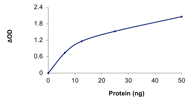
PAD1, Active (P312-310G)
FOR BULK ORDER REQUESTS PLEASE CONTACT US
Description : Recombinant full-length human PAD1 was expressed by baculovirus in Sf9 insect cells using an N-terminal GST tag.
Species : Human
Tag : GST tag
Expression System : Sf9 insect cells using baculovirus
Sequence : Full length
Genbank Number : NM_013358
Specific Activity : Sample Activity Plot. For specific information on a given lot, see related technical data sheet.

Purity : Sample Purity Data. For specific information on a given lot, see related technical data sheet.

Storage, Stability and Shipping : Store product at –70oC. For optimal storage, aliquot target into smaller quantities after centrifugation and store at recommended temperature. For most favorable performance, avoid repeated handling and multiple freeze/thaw cycles.
Molecular Weight : ~95 kDa
Gene Aliases : HPAD10; PADI1; PDI; PDI1
Scientific Background : PAD1 is a member of the peptidyl arginine deiminase family of enzymes, which catalyze the post-translational deimination of proteins by converting arginine residues into citrullines in the presence of calcium ions. PAD1 is a component of the 26S proteasome, a multiprotein complex that degrades proteins targeted for destruction by the ubiquitin pathway. The overexpression of PAD1 induced a distinctive pattern of multidrug resistance in mammalian cells and moderate resistance to ultraviolet light (1). PAD1 is also responsible for substrate deubiquitination during proteasomal degradation (2).
References :
1. Spataro, V. et.al: Resistance to diverse drugs and ultraviolet light conferred by overexpression of a novel human 26 S proteasome subunit. J. Biol. Chem. 272: 30470-30475, 1997.
2. Yao, T. et.al: A cryptic protease couples deubiquitination and degradation by the proteasome. Nature 419: 403-407, 2002.
Product Sheets: (by Lot #):
Research Areas : Inflammation,
